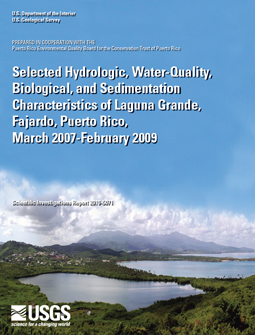Scientific Investigations Report 2010–5071

AbstractLaguna Grande is a 50-hectare lagoon in the municipio of Fajardo, located in the northeasternmost part of Puerto Rico. Hydrologic, water-quality, and biological data were collected in the lagoon between March 2007 and February 2009 to establish baseline conditions and determine the health of Laguna Grande on the basis of preestablished standards. In addition, a core of bottom material was obtained at one site within the lagoon to establish sediment depositional rates. Water-quality properties measured onsite (temperature, pH, dissolved oxygen, specific conductance, and water transparency) varied temporally rather than areally. All physical properties were in compliance with current regulatory standards established for Puerto Rico. Nutrient concentrations were very low and in compliance with current regulatory standards (less than 5.0 and 1.0 milligrams per liter for total nitrogen and total phosphorus, respectively). The average total nitrogen concentration was 0.28 milligram per liter, and the average total phosphorus concentration was 0.02 milligram per liter. Chlorophyll a was the predominant form of photosynthetic pigment in the water. The average chlorophyll-a concentration was 6.2 micrograms per liter. Bottom sediment accumulation rates were determined in sediment cores by modeling the downcore activities of lead-210 and cesium-137. Results indicated a sediment depositional rate of about 0.44 centimeter per year. At this rate of sediment accretion, the lagoon may become a marshland in about 700 to 900 years. About 86 percent of the community primary productivity in Laguna Grande was generated by periphyton, primarily algal mats and seagrasses, and the remaining 14 percent was generated by phytoplankton in the water column. Based on the diel studies the total average net community productivity equaled 5.7 grams of oxygen per cubic meter per day (2.1 grams of carbon per cubic meter per day). Most of this productivity was ascribed to periphyton and macrophytes, which produced 4.9 grams of oxygen per cubic meter per day (1.8 grams of carbon per cubic meter per day). Phytoplankton, the plant and algal component of plankton, produced about 0.8 gram of oxygen per cubic meter per day (0.3 gram of carbon per cubic meter per day). The total diel community respiration rate was 23.4 grams of oxygen per cubic meter per day. The respiration rate ascribed to plankton, which consists of all free floating and swimming organisms in the water column, composed 10 percent of this rate (2.9 grams of oxygen per cubic meter per day); respiration by all other organisms composed the remaining 90 percent (20.5 grams of oxygen per cubic meter per day). Plankton gross productivity was 3.7 grams of oxygen per cubic meter per day, equivalent to about 13 percent of the average gross productivity for the entire community (29.1 grams of oxygen per cubic meter per day). The average phytoplankton biomass values in Laguna Grande ranged from 6.0 to 13.6 milligrams per liter. During the study, Laguna Grande contained a phytoplankton standing crop of approximately 5.8 metric tons. Phytoplankton community had a turnover (renewal) rate of about 153 times per year, or roughly about once every 2.5 days. Fecal indicator bacteria concentrations ranged from 160 to 60,000 colonies per 100 milliliters. Concentrations generally were greatest in areas near residential and commercial establishments, and frequently exceeded current regulatory standards established for Puerto Rico. |
First posted May 21, 2010 For additional information contact: Part or all of this report is presented in Portable Document Format (PDF); the latest version of Adobe Reader or similar software is required to view it. Download the latest version of Adobe Reader, free of charge. |
Soler-López, L.R., and Santos, C.R, 2010, Selected Hydrologic, Water-Quality, Biological, and Sedimentation Characteristics of Laguna Grande, Fajardo, Puerto Rico, March 2007-February 2009: U.S. Geological Survey Scientific Investigations Report 2010–5071, 51 p., available at http://pubs.usgs.gov/sir/2010/5071/.
Abstract
Introduction
Purpose and Scope
Description of Study Area
Methods of Investigation
Bathymetric Survey
Surface-Water and Rainfall Data Collection
Water-Quality Sampling and Analysis
Determination of Biological Characteristics
Sediment Core Collection
Bathymetry
Selected Hydrologic Characteristics
Rainfall and Runoff
Seawater Exchange
Water Quality
Field-measured properties and constituents
Temperature
Turbidity
pH
Dissolved Oxygen
Specific Conductance
Salinity
Water Transparenc
Other Chemical Constituents
Nitrogen and Phosphorus
Chlorophyll a
Biological Characteristics
Primary Productivity
Phytoplankton Net Primary Productivity, Plankton Respiration, and Plankton
Gross Productivity
Community Net Primary Productivity, Respiration, and Gross Productivity
Phytoplankton Biomass
Fecal Indicator Bacteria
Sediment Accretion
Summary and Conclusions
References